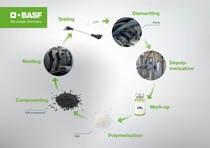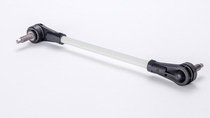Plastics & Rubber
From old to new: PA6 Depolymerization
Old Car Plastics? We’re Giving Them a Fresh Start!
BASF, Mercedes-Benz, and ZF Group have teamed up to do something pretty cool: demonstrating how even heavily used and contaminated plastic parts made from Polyamid 6 (PA6) can be recycled into virgin like polymer compounds at pilot scale using a recycling method called depolymerization. Normally, these parts would just get burned. Now? They get a second chance.
Turning contaminated Polyamide 6 (PA6) parts into new plastics
The pilot project aims at transforming heavily used and contaminated Polyamide 6 (PA6) automotive parts into virgin-like polymer compounds using a recycling process called depolymerization. This method, already well established for the recycling of PA6 in the textile industry, has now been adapted to also handle glass fiber–reinforced automotive plastic parts which may contain unknown additives and contaminants. Today, the fate of these components is typically incineration. Depolymerization is a promising and sustainable alternative instead.
The depolymerisation process
Through depolymerization, plastics such as Polyamide 6 (PA6) or Polybutylene terephthalate (PBT) can be broken down into their fundamental building blocks and rebuilt into high quality plastics again. In the pilot project, disassembled PA6 parts from end-of-life vehicles were used, along with contaminated PA6 oil pans originating from the remanufacturing of drivetrain modules. Curious how it works? Let’s take a closer look at the process.

Step 1: Clean & shred
After dismantling the parts from the car they are cleaned and chopped into small pieces using state-of-the-art technology.
Step 2: Break it down - the actual depolymerisation
The shredded plastic is broken down into its basic building blocks — called monomers. The output monomer of the PA6 depolymerisation is chemically Caprolactam.
Step 3: Purify
The Caprolactam is purified to guarantee high quality polymers after synthesis.
Step 4: Rebuild
The purified caprolactam is then repolymerized into a Polyamide 6 (PA6) base polymer with the target viscosity flexibly adjusted during the process.
Step 5: Boost performance
In the final compounding step, glass fibers and additives are added to make the material perform and ready for use.
Same mold, same process - just feel-good materials

Photo: BASF, 2025
The plastic compound obtained from the depolymerization of PA6 automotive parts was used to manufacture a stabilizer link for a Mercedes-Benz passenger car — a key part that connects the suspension to the stabilizer bar and helps to keep the car steady during turns and fast driving. The parts were molded by ZF Group using the same tools and process as in regular production, with only minor tweaks. In parallel test specimens were produced at BASF’s pilot center.
And the results? The recycled material performs just like new. Mechanical tests show no difference compared to fossil-based plastics. This demonstrates that the recyclate meets the highest quality standards and is suitable for demanding automotive applications - without compromising performance or other chemical and physical properties.
This project highlights the potential of recycled plastic - even for technically demanding applications - and underlines ZF's innovative strength in establishing sustainable material cycles.
To better understand the impact of the recycling process and the materials it produces, a life cycle assessment (LCA) was carried out with support from ETH Zurich’s Energy & Process Systems Engineering Team.
The results speak for themselves: CO₂ emissions were significantly lower compared to producing conventional fossil-based plastics. Even more impressive — the savings were even greater when compared to burning old car parts, which were instead used as raw material for recycling.
These findings show how advanced recycling can make a real difference in building a circular economy and driving the sustainable transformation of the plastics industry — as long as the right regulations are in place to support it.
Mercedes-Benz is committed to the use of secondary raw materials in its vehicles today and in the future as part of resource conservation and circularity. To continuously increase the availability of such sought-after secondary materials, the expansion of existing and new recycling technologies is essential. Pilot projects along the value chain are of central importance to continuously expand the range of recycling processes used and to gain well-founded insights. This technological diversity is another important step in making our contribution to resource conservation.


